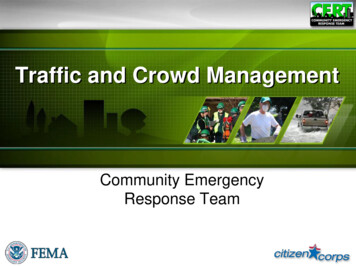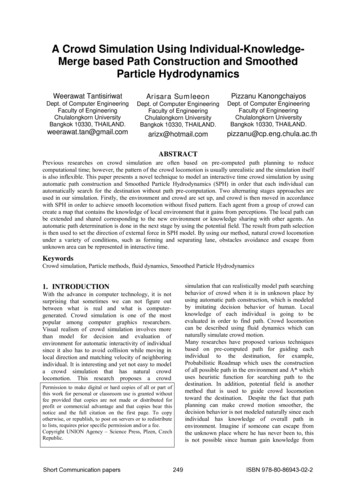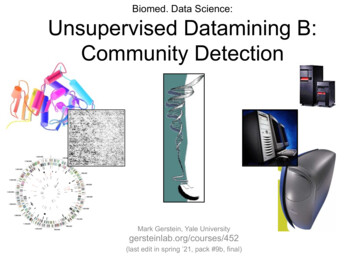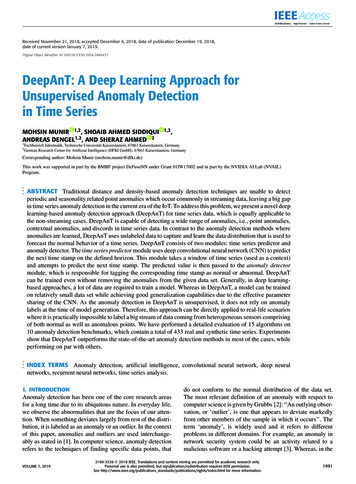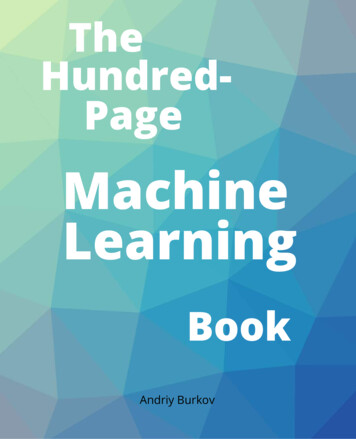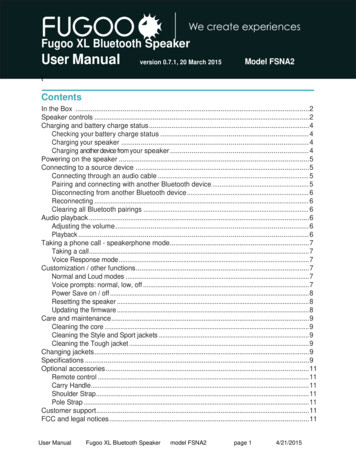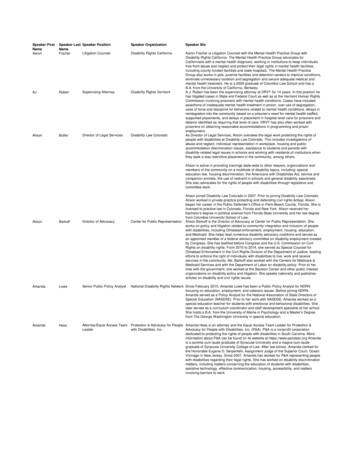
Transcription
Crowd : Unsupervised Speaker Count with SmartphonesChenren Xu† , Sugang Li† , Gang Liu§ , Yanyong Zhang†Emiliano Miluzzo , Yih-Farn Chen , Jun Li† , Bernhard Firner††WINLAB, Rutgers University, North Brunswick, NJ, USA AT&T Labs - Research, Florham Park, NJ, USA§Center for Robust Speech Systems, University of Texas at Dallas, Richardson, TX, USAABSTRACTSmartphones are excellent mobile sensing platforms, with themicrophone in particular being exercised in several audio inference applications. We take smartphone audio inference astep further and demonstrate for the first time that it’s possible to accurately estimate the number of people talking in acertain place – with an average error distance of 1.5 speakers – through unsupervised machine learning analysis on audio segments captured by the smartphones. Inference occurstransparently to the user and no human intervention is neededto derive the classification model. Our results are based onthe design, implementation, and evaluation of a system calledCrowd , involving 120 participants in 6 very different environments. We show that no dedicated external hardware orcumbersome supervised learning approaches are needed butonly off-the-shelf smartphones used in a transparent manner.We believe our findings have profound implications in manyresearch fields, including social sensing and personal wellbeing assessment.ACM Classification KeywordsC.3 Special-Purpose and Application-Based Systems: MiscellaneousGeneral TermsAlgorithms, Design, Experimentation, Human FactorsAuthor KeywordsAudio Sensing, Smartphone Sensing, Speaker CountingINTRODUCTIONThe most direct form of social interaction occurs through thespoken language and conversations. Given its importance,for decades scientists have proposed diverse methodologiesto analyze the audio recorded during people’s conversationsto distill the various attributes that characterize this particularsocial interaction. In addition to the most obvious attributesPermission to make digital or hard copies of all or part of this work forpersonal or classroom use is granted without fee provided that copies are notmade or distributed for profit or commercial advantage and that copies bearthis notice and the full citation on the first page. Copyrights for componentsof this work owned by others than ACM or the author must behonored. Tocopy otherwise, or republish, to post on servers or to redistribute to lists,requires prior specific permission and/or a fee.UbiComp ’13, Sept 9-12, 2013, Zurich, Switzerland.Copyright 2013 ACM 978-1-4503-1770-2/13/09. 15.00.of a conversation, i.e., its content [28], several types of contextual cues have also received attention including speakeridentification, conversation turn-taking, and characterizationof a social setting [9, 22, 13]. We, however, note that oneof the most important contextual attributes of a conversation,namely, speaker count, has been largely overlooked. Speakercount specifies the number of people that participate in a conversation, which is one of the primary metrics to evaluate asocial setting: how crowded is a restaurant, how interactiveis a lecture, or how socially active is a person [27, 24]. Inthis paper, we aim to accurately extract this attribute fromrecorded audio data directly on off-the-shelf smartphones,without any supervision, and in different use cases.Most of the previous studies that focused on the extractionof conversation features all share a common thread: they often require specialized hardware – such as microphone arrays, external dongles pairing with mobile phones, or videocameras – and complex machine learning algorithms builtupon supervised training techniques requiring the collectionof large and diverse data sets to bootstrap the classificationmodels. The support of powerful backend servers is also often needed to drive these algorithms.Given that smartphones are becoming increasingly powerfuland ubiquitous, it is natural to envision new social monitoringarchitectures, with the smartphones being the only sensingand computing platform. In pursuit of these goals, we designa system called Crowd , where we exploit the audio fromthe smartphone’s microphone to draw the social fingerprintsof a place, an event, or a person. We do so by inferring thenumber of people in a conversation – but not their identity –as well as their interactions from the analysis of the voicescontained in the audio captured by the smartphones, withoutany prior knowledge of the speakers and their speech characteristics. Audio inference from smartphones’ microphoneshas been previously used to characterize places and events bypicking up different sound cues in the environment [3]. However, for the first time, we show how to infer the number ofspeakers in a conversation through voice analysis using theaudio recorded on off-the-shelf smartphones.Crowd is unique given its number of contributions: (i)it is entirely distributed, with no infrastructure support; (ii)it applies completely unsupervised learning techniques andno prior training is needed for the system to operate; (iii) it
is self-contained, in that, the sensing and machine learningcomputation takes place entirely and efficiently on the smartphone itself as shown by our implementation on four differentAndroid smartphones and two tablet computers; (iv) it is accurate, as shown by experiments where Crowd is used inchallenging environments with different audio characteristics– from quiet to noisy and loud – with the phone both insideand outside a pocket, and very short audio recordings; and (v)it’s energy and resource-efficient.In spite of Crowd not being perfect and potentially affectedby limitations – the count is based on active speakers andnoise can possibly impact the count accuracy – we still believe that ours is a competitive approach in many differentapplication scenarios. In the social realm for example: people are often interested in finding “social hotspots,” whereoccupants engage in different social behaviors: examples arerestaurants, bars, malls, and meeting rooms. What if we couldknow in advance the number of people in a certain bar orrestaurant? It might help us make more informed decisionsas to which place to go.While Crowd may be deemed only as an initial step, weshow that faithful people count estimates in conversations cannevertheless be achieved with sufficient accuracy. We implement Crowd on five Android smartphones and two tabletcomputers and collect over 1200 minutes of audio over thecourse of three months from 120 different people. The audio is recorded by Crowd in a range of different environments, from quiet ones – home and office – to noisy placeslike restaurants, malls, and public squares. We show that theaverage difference between the actual number of speakers andthe inferred count with Crowd is slightly over 1 for quietenvironments, while being no larger than 2 in very noisy outdoor environments. We conjecture that this accuracy is adequate and meaningful for many applications – such as socialsensing applications, crowd monitoring and social hotspotscharacterization just to name a few – that don’t necessitateexact figures but only accurate estimates.MOTIVATION AND CHALLENGESSpeaker count is an important type of contextual informationabout conversations. Crowd is able to infer the number ofspeakers in a dialog without requiring any prior knowledge ofthe speech characteristics of the involved people because ofits unsupervised nature. We believe that the ability to capturethis information can support different classes of applications,some of which are summarized below.Crowd Estimation and Social Hotspots Discovery. WithCrowd it would be possible to estimate the number of people talking in certain places, such as restaurants, pubs, malls,or even corporate meeting rooms. This information is usefulto assess the occupancy status of these places.One question that comes to mind is: Why do we need a solution like Crowd to infer the number of people in a place?Wouldn’t be enough to simply count the number of WiFi devices associated with an access point, piggyback to a bluetooth scan result, measure co-location, use computer visiontechniques to analyze the number of people in video images,or even use active methods that require the transmission andanalysis of audio tones? The answers to these questions arequite straightforward: none of these techniques in isolation isthe solution to the problem. In order to read the associationtable of an access point there is a need to have access to theWiFi infrastructure, which is often not allowed. Even if possible, a person with several WiFi devices may generate falsepositives. A count based on the result of a bluetooth discovery [34] is error-prone because of the likelihood of reachingout to distant devices. RF-based device-free localization techniques [36] require the support of an infrastructure of severalradio devices. Acoustic-based counting engines as in [14]are error-prone because of surrounding noise and audio sensitivity to clothes. Counting people through computer vision techniques [7] requires customized infrastructure, suffersfrom privacy concerns, and is limited by lighting condition.Crowd inference is instead based on a much more localizedevent – speech – that can significantly scope the count inference to specific geographic regions. It’s also passive, since noactive sounds by the devices need to be played.We generally assume that people usually engage in conversations in social public spaces such as restaurants, bars, orconference rooms. We also acknowledge that in other places,such as subway stations or movie theaters, silence is predominant, making it difficult for Crowd to properly operate.We, however, note that Crowd should not be deemed asa replacement of any of the existing approaches. Rather, itshould be seen as a complementary solution that can be usefulto boost the crowd count accuracy by working in concert withdifferent techniques. Prior information about a certain place– such as the average number of people attending the place –combined with the properties of statistical sub-sampling canalso be used to boost the final count accuracy.Personal Social Diary. Doctors analyze their patients’ social patterns to predict depression or social isolation and takeearly actions. Rather than using ad-hoc hardware as in [27],which could potentially perturb the quality of the measurements, Crowd is installed on the smartphones of peoplepotentially affected by depression and operates unobtrusivemonitoring in a much more scalable, and less invasive fashion. These patients’ social pattern could in fact be drawn bythe social engagement captured by Crowd as the patientsgo about their daily lives.Participant Engagement Estimation. What if a teachercould assess, after a lecture, the level of engagement of theirstudents by simply looking at the number of students participating in discussions during the lecture and the frequency ofthe discussions? This could be used as an indirect measureof the class engagement and of the teacher’s effort in improving the quality of their teaching. Students would in turn bemotivated to run Crowd on their devices in order to sharewith their friends, and in turn apprehend from other students,information on the most lively lecture on campus.ChallengesAs in other smartphone audio inference applications,Crowd is affected by some challenges: the phone’s location, e.g., in or out of a pocket or bag, smartphone’s hardware
constraints, and noise polluting the audio are the main limiting factors. Despite these limitations, we show through thedevelopment and evaluation of Crowd that the system isable to efficiently and accurately perform speaker count in adiverse set of environments and settings.DigitizedAudio SignalFramingHammingWindowsPRIVACYIt is quite natural to raise privacy concerns when doing audio analysis. These concerns become more serious when theaudio is captured with a smartphone, which is always withthe user, even in private spaces. With this in mind, we takespecific steps to make sure that users’ privacy is preserved.Speakers’ identity is never revealed. Crowd isn’t ableto associate a voice fingerprint to a specific person and it’sdesigned to only infer the number of different speakers inan anonymized manner. Crowd could potentially identifyonly the phone’s owner if the algorithm was actively trainedto recognize the owner’s voice. Identification of the ownermay be optionally added to either improve the speaker countaccuracy or in personal social diary applications.The audio analysis is always performed locally on devices inorder to avoid sensitive data leaks. The audio is deleted rightafter the audio features computation. Should communicationwith backend be needed, the servers should be trusted and offthe-shelf encryption methods for the communications shouldbe put in place. Only features extracted from the audio, ratherthan the raw audio itself, should be sent to the server.To guarantee the user’s privacy when the data is sent to abackend server and to prevent attacks that exploit the audiofeatures to reconstruct the original audio, measures such asthe ones proposed by Liu et al. [18] should be put in place.In this work, it is shown how to manipulate the features to apoint that they are still effective for a machine learning algorithm to infer events while, however, obfuscating the underlying content of the raw audio.Finally, by giving users the ability to configure the application’s settings, Crowd should be allowed to workonly in specific locations – say, in public places. Throughgeo-fencing technologies, the application could be automatically activated and deactivated as directed by the user’s preselected policies: e.g., activate it in the office and in restaurants but not at home.SYSTEM DESIGNCrowd estimates the number of active speakers in a groupof people. It consists of three steps: (1) speech detection, (2)feature extraction, and (3) counting. In the speech detectionphase, we extract the speech segments from the audio databy filtering out silence periods and background noise. In thefeature extraction phase, we compute the feature vectors fromthe active speech data. In the counting phase, we first selectthe distance function that is used to maximize the dissimilarity between different speakers’ voice, and then apply an unsupervised learning technique that, operating on the featurevectors with the support of the distance function, determinesthe speaker count. An overview of the Crowd pipelinedapproach is shown in Figure ionUnsupervisedcounting algorithmFigure 1. Crowd sequence of operations.Speech DetectionAs soon as an audio clip is recorded, we segment the clip intosmaller segments of equal length. Each segment, which is3-second long, is the basic audio processing unit. Throughexperimentation we find this duration to be acceptable forthe trade-off between inference delay and inference accuracy.It also captures adequately the turn-taking pattern normallypresent in everyday conversations [22]. This choice is alsosupported by previous studies showing that the median utterance duration of telephone conversations between customersof a major U.S. phone company and its customer service representatives is 2.74 seconds [31].The result of the segmentation of an audio clip S is a sequenceof N different segments, S {S1 , S2 , ., SN }. Next we filter out segments containing long periods of silence or wherenoise is predominant. We use each segment’s pitch value forthis purpose.Pitch [32] is directly related to the speaker’s vocal cord, andtherefore, by being intimately connected with the speaker vocal trait, it’s robust against noise and other external factors.Pitch has been widely used in speaker identification [5] andspeaker trait identification [20] problems. When estimatedaccurately, pitch information can be used to assist the voiceactivity detection task in a noisy acoustic environment. Inthis study, we select YIN [8], a time-domain pitch calculationalgorithm based on autocorrelation. While some other pitchestimation algorithms, such as Wu [35] and SAcC [17], mightexhibit better accuracy, YIN is simpler, more energy-efficient,and robust to noise – hence more suitable for mobile devices.Traditionally, energy-based methods such as the ones discussed in [11] have been used for voice data detection, butthey are unsuitable for processing audio collected by smartphones. When recording audio, smartphones are usuallyplaced at a certain distance from the speakers. As a result,even in absence of speech, the ambient audio energy couldbe high enough to trigger false positives in energy-based algorithms. Pitch, on the other hand, is a better alternative be-
100100Same speakerDifferent speakers100Same speakerDifferent speakers60406040202000[0,20)[20,40)[40,60)[60,80) [80,100)Cosine Similarity Distance(a) One-second utteranceSame speakerDifferent speakers80Density (%)80Density (%)Density (%)806040200[0,20)[20,40)[40,60)[60,80) [80,100)[0,20)Cosine Similarity Distance[20,40)[40,60)[60,80) [80,100)Cosine Similarity Distance(b) Two-second utterance(c) Three-second utteranceFigure 2. Cosine similarity distance demonstrates better speaker distinguishing capabilities with longer utterance.cause human pitch is distinctly different than pitch obtainedin absence of speech.We then apply the pitch estimation algorithm on all the segments to only admit those where the pitch falls within therange of 50 to 450 Hz, the typical pitch interval for humanvoice [4]. In this way, we apply a filtering technique to remove all the segments with long periods of silence or background noise. We note that using pitch to detect speech is notalways the best approach because of pitch being only associated with voiced phoneme. However, in our setting, eachbasic acoustic segment is 3 seconds long with a probabilityof lack of voiced parts in such a time frame being quite low.In our evaluation, we collected over 1200 minutes audio andverified that pitch is a feasible solution for our purposes.Speaker Distinguishing Features and System CalibrationHaving filtered out the non-speech and background noise audio segments, our next step is to extract the features that canefficiently distinguish speakers. We have explored variousfeature sets that are largely used in the speech processingcommunity, such as LPCC [23], RASTA [12], and differentcombinations of them. We find that MFCC [10] and pitch,when used together, provide the best inference results. In thefollowing, we discuss the details on how these feature vectorsare used in our counting algorithm.MFCC and its Distance MetricMFCC is one of the most effective and general-purpose features in speech processing [10]. In Crowd , we use the coefficients between the 2nd and the 20th coefficient in ordernot to model the DC (direct current) component of the audiofrom the first coefficient. A 19-dimensional MFCC vector isthen formed out of each 32 msec frame.In order to perform the counting, we need to rely on a distance metric that allows Crowd to distinguish speech fromdifferent speakers by comparing MFCC vectors from different audio segments. An ideal distance metric should demonstrate a perfect discriminative capability when computed ondata from two different speakers. After investigating severalcommon distance metric options – e.g., Average Linkage and2-Gaussian Mixture Model (GMM) Generalized LikelihoodRatio (GLR)1 – we find that Cosine Similarity (CS) is the bestcandidate as it minimizes the computation overhead in termsof real-time factor (RTF), defined as the processing time per1We use 2-GMM because a higher order GMM fails to converge inthe parameter fitting phase.second, and the expected error probability (EEP) metric. TheEEP is defined as:Z Z τp (x ωs ) dx,p (x ωd ) dx τwhere p (x ωs ) and p (x ωd ) represent, respectively, the probability density functions (pdfs) of the distance from the samespeaker and different speakers, and τ is the data point wherethese two pdfs present the same value. Table 1 shows thatthe best performance for both the RTF and EEP metrics isachieved using CS. This confirms the superiority of the CSdistance compared to a GMM approach, heavily used in theliterature in audio processing applications.Distance ModelEEPRTFCosine Similarity (CS)0.1687 0.003Average Linkage (AL)0.5787 0.012-Gaussian Mixture Model (GMM) 0.5742 1.17Table 1. Cosine Similarity outperforms Average linkage and 2-GaussianMixture Model in terms of expected error probability (EEP) and realtime factor (RTF) based on 3-second utterances.For the audio data processing, we partition the data intosmaller segments, and assume the speech within a segmentbelongs to the same speaker. We then calculate the MFCCvectors for each segment and determine whether two segments belong to the same speaker by looking at their distance.We plot the cosine similarity distance density with differentsegment lengths (1, 2, 3 seconds) in Figure 2. We observethat the size of the overlap decreases as the length of the segment increases, which confirms the intuition that it is easierto distinguish multiple speakers when longer samples are collected. Finally, Figure 2 also provides hints about the bestpossible CS distance threshold that allows the differentiationof different speakers.Pitch and Gender IdentificationIn addition to assisting the speech detection process as discussed above, pitch can also be used to identify the gender ofthe speaker because the most distinctive trait between maleand female voices is their fundamental frequency or pitch.The average pitch for men falls between 100 and 146Hz,whereas for women it is usually between 188 and 221Hz,as demonstrated in [4]. By relying on gender identification,Crowd speaker count accuracy is increased because of itsdisambiguation role. For instance, if two participants (onemale and the other female) present similar MFCC features,their pitch difference can help distinguish between the two.
Crowd Counting EngineThe last step is about the computation of the speaker count.Having extracted n different audio segments containing human voice, Crowd derives the feature vectors from eachsegment. Let M1 , M2 , ., Mn be the sequence of feature vectors for all the segments, where Mi is the MFCC feature vectors for segment Si .Our counting algorithm involves two rounds. In the firstround, we aggregate neighboring segments that produce similar features. Traditional speech processing methods useagglomerative hierarchical clustering [15] that requires thecomparison between each segment with every other segment in the set, which incurs a computational complexity ofO(n2 ). We instead employ a much more lightweight clustering method, i.e., forward clustering, which needs to visitall the segments only once. In forward clustering, we startfrom segment 1 (i.e., S1 ), and compare it against S2 . If theirMFCC features are close enough, i.e., dCS (M1 , M2 ) θs ,we merge these two segments into a new S1 . Next we compare this new S1 with S3 . If they are still similar, we willmerge them too. Otherwise, we stop comparing with S1 , andbegin to compare S3 and S4 . In contrast with hierarchicalclustering, forward clustering incurs much less computationand energy overhead given its linear time complexity O(n).The rationale behind forward clustering is that there usuallyexists temporal correlation in speech – the likelihood of contiguous segments containing the same voice is high when thesegments are short enough. After running the forward clustering algorithm, we have fewer and longer segments, to theresult of the merging step. We also note that longer segmentshave better performance in distinguishing different speakersand further boost counting accuracy.Let’s now denote with C the set of inferred speakers. Whencomputing the distance dCS (i, j) between two different feature vectors Mi (which is the MFCC vector from a new segment i) and Nj (which is the MFCC vector of a previouslyinferred speaker, Cj ) we have three possible outcomes: Existing Speaker: If dCS (i, j) θs and we infer a samegender, then we treat these two voice segments as belonging to the same person, namely Cj . In this case, we do notupdate C by adding new inferred speakers, but only updateCj ’s MFCC vector as Mi . If this condition is true for multiple existing speakers, we update the MFCC of the speakerthat gives the lowest CS distance. New Speaker: If dCS (i, j) θd or different genders areinferred for all the members in C, we then tag this voicedata as from a new speaker, the C 1-th speaker, andadd it to the admitted crowd C, where C denotes the sizeof C. Uncertainty: If dCS (i, j) θs for all j’s but dCS (i, k) θd for some k (both j, k C ), then we cannot decidewhether this utterance is from an existing speaker or a newspeaker. In this case, we discard this data point.The θs and θd thresholds are empirically determined in thecalibration phase before we conduct the evaluation. We notethat the optimal threshold values may vary across differentphone models because the microphones have different internal sensitivity levels. The choice of these two thresholds isdriven by the desire to be conservative in the discovery of newspeakers while minimizing the number of false positives.To summarize, our counting algorithm is designed to be robust and resource-aware. To this end, we rely on an energyefficient and noise-resilient pitch estimation algorithm, andintroduce the cosine similarity distance function, an efficientdistance metric at the core of our counting engine.EVALUATIONA detailed description of the Crowd evaluation results ispresented in this section.Crowd App ImplementationWe have implemented Crowd on the Android platform using Java and installed it on multiple smartphones – HTC EVO4G, Samsung Galaxy S, S2, S3, Google Nexus 4, – and tablets– Samsung Galaxy Tab 2 and Google Nexus 7. The raw audiois recorded at an 8 KHz frequency, 16 bit pulse-code modulation (PCM). We use 32 msec hamming window with 50%overlap for computing the MFCC, and the YIN pitch tracker.The code base of Crowd has been optimized to minimizethe CPU processing time and energy consumption.Energy considerationsIn Table 2, we report the latency for processing 1-secondaudio segments in terms of MFCC and pitch computation,and the time needed to run the speaker count algorithm onthe different devices. The results show that Crowd execution time is fast, topping 320 msec and only 171 msec ona Galaxy S3. In addition, we demonstrate Crowd energyefficiency in a continuous sensing scenario. We adopt theduty-cycling approach of recording for 5-minutes followedby the speaker count algorithm and sleeping for T minutes.We choose the Galaxy S2 phone and plot in Figure 3 thephone’s battery duration as a function of the sleep time Tbetween consecutive recordings (similar results can be foundfor other devices). We observe that even with short sleepingintervals, i.e., 15 minutes, the phone can last up to 23 hours.All the measurements are collected with the WiFi service running in background on the phone. These battery durationsare all compatible with the use of a phone in a normal dailyroutine. It has to be noted that these battery durations areachieved with a fixed duty-cycle policy, providing a performance lower bound. Given that Crowd would mostly runin public spaces only, longer sleeping intervals would extendthe battery duration even further.Latency HTCSamsungSamsungGoogleGoogle(msec)EVO 4g Galaxy S2 Galaxy S3 Nexus 4 Nexus 0.77267.54171.53154.32151.7Table 2. Average latency for processing 1-second audio for MFCC calculation, Pitch calculation, and speaker counting using different phonemodels.
Battery level (%)100various conversation group sizes and phone positions. The error count distance is usually within 1, sometimes 2, and veryrarely 3 (in 2 out of 40 cases). From this set of results, we candraw the following conclusions: First, in a quiet indoor environment, Crowd gives accurate speaker count estimates.Second, the phone’s position on the table does not have anobvious impact on the inference accuracy.15 mins duty cycle30 mins duty cycle60 mins duty cycle80604020Counting Accuracy when Phones on Table vs. in Pocket00510152025303540Time (hr)Figure 3. A duty-cycle of 15 mins guarantees a one day battery life forthe Samsung Galaxy S2.Performance MetricWe define Error Count Distance as Ĉ C , where C is theactual number of speakers and Ĉ is the estimated speakercount. The metric is calculated using the absolute value ofthe error to avoid the terms canceling out because of theirpositive and negative contributions. The average error countdistance is a proxy for the Crowd count accuracy.MFCC and Pitch ParametersBefore the feature computation of an arbitrary speech segment, we first need to set appropriate values for the parameters required by the CS metric to properly operate. For thispurpose, we have performed a preliminary calibration phaseat the beginning of the study, where we collect audio from10 participants (5 males and 5 females) from different countries with different accents. To guarantee robust calibration,we use different phone models mentioned earlier with different placements (on the table and in the pocket), different distances (in a range of 2 meters), and orientations with respectto the speaker. We empirically chose 15 and 30, respectively,for the θs and θd thresholds used by the cosine similarity distance metric introduced in the previous section. θs and θdare chosen as the median value from p (x ωs ) and p (x ωd ),which is a little off from τ mentioned earlier to filter out thespeech containing overlap and pause.P
a system called Crowd , where we exploit the audio from . Even if pos-sible, a person with several WiFi devices may generate false positives. A count based on the result of a bluetooth discov- . such as subway stations or movie theaters, silence is predom-inant, making it difficult for Crowd to properly operate. .

